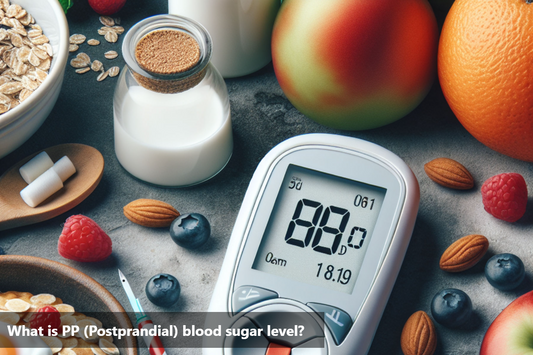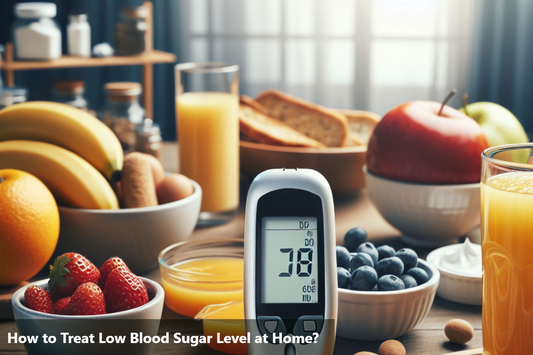What level of blood sugar is dangerous?
Keeping an eye on blood sugar levels is key for health. Also called blood glucose levels, blood sugar plays a big role in keeping our bodies working properly. To understand why it matters, it helps to know some basic terms.
When we talk about blood sugar, you may hear "fasting" levels or "postprandial" levels. Fasting blood sugar is the amount of glucose in our blood after not eating for a stretch. This gives a baseline for how our body handles sugar. Postprandial levels show how our body deals with sugar after we eat - a more dynamic picture.
But understanding these measurements isn't just about numbers - it's about tuning into our body's language. As we explore this, we'll focus on what blood sugar levels may be risky for our health. Knowing this helps us make choices today for a healthier future. Let's start learning how blood sugar connects to our overall well-being.
Normal Blood Sugar Levels
Now that we've set the groundwork, let's talk about regular blood sugar levels. Typically, when you haven't eaten for a while (like overnight), your blood sugar levels are usually between 70 and 100 milligrams per deciliter (mg/dL). This gives us a baseline to see how our bodies handle glucose when we're at rest.
After eating, blood sugar levels usually reach their highest point, which is below 140 mg/dL, within two hours. Checking this after-meal level helps us understand how well our bodies process and use glucose from food.
Blood Sugar Level Ranges (mg/dL)
Age Group |
||
|---|---|---|
Children |
70-100 |
Up to 140 |
Adults |
70-100 |
Up to 140 |
Men |
70-100 |
Up to 140 |
Women |
70-100 |
Up to 140 |
Older Adults |
70-100 |
Up to 140 |
These ranges are approximate and can vary depending on individual health conditions, medications, and other factors. It's important for individuals to consult with healthcare providers for personalized blood sugar level targets and management strategies, especially for those with diabetes or other metabolic conditions.
Think of it like keeping a balanced environment inside your body. Just like a garden needs the right mix of sunlight and water to thrive, our bodies do well when blood sugar levels are in balance. Maintaining this balance doesn't just protect against immediate issues but also sets the stage for a healthier future. So, let's understand why these normal ranges matter and how they contribute to the harmony of our well-being.
Dangerous Blood Sugar Levels
Let's talk about high blood sugar levels, which can be risky for our health. When our blood sugar is over 126 mg/dL after not eating (fasting) or consistently above 200 mg/dL after eating (postprandial), it's a cause for concern. These high levels can lead to health problems that we shouldn't ignore.
In simpler terms, if our fasting blood sugar goes beyond 126 mg/dL, it might mean our body is having trouble using insulin or handling sugar properly. This can increase the chance of developing Type 2 diabetes, a long-term condition that affects many people worldwide. Similarly, if our post-meal sugar levels regularly go above 200 mg/dL, it can strain our body's ability to control sugar, raising the risk of diabetes-related issues.
Knowing these numbers is like having a guide for staying healthy. High blood sugar isn't just a risk for diabetes; it's also linked to heart problems, issues with the kidneys, and damage to nerves.
Think of it as a warning sign – a signal that our body's balance is off. Ignoring these signs could lead to more serious health problems later on. By recognizing the risks of high blood sugar, we can take steps to protect our health. Let's understand what these high numbers mean and find ways to keep our health journey away from these potential dangers.
Factors Influencing Blood Sugar Levels
Dietary Intake: Consuming foods high in carbohydrates, especially those with a high glycemic index (GI), can cause rapid increases in blood sugar levels. Conversely, meals balanced with protein, fiber, and healthy fats can slow down digestion and help stabilize blood sugar.
Physical Activity: Exercise increases the body's demand for energy, causing muscles to use glucose more efficiently. This can lead to a temporary decrease in blood sugar levels during and after physical activity.
Hormonal Changes: Hormones such as insulin (which lowers blood sugar) and glucagon (which raises blood sugar) play crucial roles in regulating glucose levels. Hormonal fluctuations due to stress, menstrual cycles, or medical conditions can impact blood sugar regulation.
Medications: Certain medications, including insulin and oral diabetes medications, directly influence blood sugar levels. Adjustments in dosage, timing, or type of medication can affect how effectively glucose is managed in the body.
Stress: Stress triggers the release of hormones like cortisol and adrenaline, which can cause blood sugar levels to rise temporarily. Chronic stress can also affect insulin sensitivity, leading to long-term fluctuations in blood sugar.
Illness and Infection: Infections or illnesses can cause an inflammatory response in the body, releasing stress hormones that elevate blood sugar levels. Managing blood sugar levels during illness is crucial, especially for individuals with diabetes.
Sleep Patterns: Inadequate or poor-quality sleep can disrupt hormonal balance and impair glucose metabolism, leading to higher blood sugar levels.
Dehydration: Insufficient hydration can lead to higher concentrations of glucose in the bloodstream, as the kidneys may release more glucose when the body is dehydrated.
Exercise is also important. Physical activity makes our cells better at using glucose for energy. Even a small increase in daily activity can help keep blood sugar levels more stable.
Certain health issues are also worth paying attention to. Conditions like polycystic ovary syndrome (PCOS), thyroid problems, and some medications can affect blood sugar levels. Knowing about these factors is important for understanding our health more fully.
As we look at all these factors, it's clear they together affect whether our blood sugar is at a risky level. Recognizing these influences helps us make smart choices in our daily life. By adjusting what we eat, being active, handling stress, and keeping an eye on our health, we're taking steps to keep our blood sugar within safe limits. Let's uncover how these factors work together to shape our blood sugar story.
Monitoring your blood sugar levels
In summary, we've learned a lot about blood sugar and how crucial it is for our overall health. We started by understanding terms like fasting and postprandial levels, which are important for checking how well our metabolism is working.
Next, we looked at the levels that could be risky. When fasting levels go above 126 mg/dL or postprandial levels consistently go beyond 200 mg/dL, it's not just a number – it's a warning that needs attention. High blood sugar isn't just a step towards diabetes; it can lead to problems with our heart, kidneys, and nerves.
We also explored what affects blood sugar, like what we eat, how active we are, stress, and other health issues. Knowing these things helps us take better care of our health.
The main point to remember is to keep an eye on our blood sugar regularly. This helps us make smart choices. Simple changes, like choosing good foods, staying active, and managing stress, can keep our blood sugar stable.
But it's important to know that we're not alone in this. Regular check-ups with healthcare professionals help us manage our blood sugar well. It's a team effort between us and the experts guiding us to stay healthy.
In conclusion, let's act on what we've learned. Keep an eye on, make changes, and talk to the experts. By keeping our blood sugar in check, we protect ourselves and set the stage for a healthier, more energetic life. Our health is a gift, and it's up to us to take care of it.
This Blog post is an initiative by DiabeSmart, to provide accurate and Nutritionist / Doctor approved information related to Diabetes. DiabeSmart is India's first Food brand designed specifically for Diabetics, that has been clinically tested on Diabetics and Pre-Diabetics to deliver 55% - 70% lower Sugar spikes. DiabeSmart is part of Lo! Foods - India's leading brand for Everyday Functional Health foods.













